European Gas Security: The Future of Natural Gas
Posted by Euan Mearns on May 13, 2008 - 10:00am in The Oil Drum: Europe
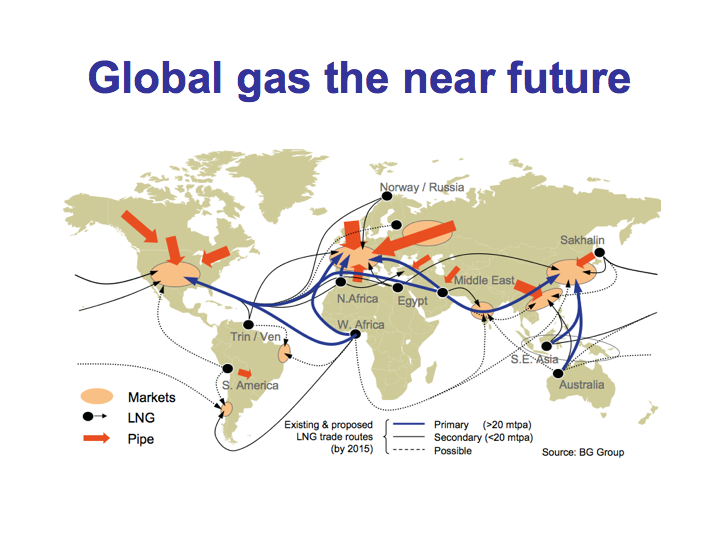
This is the talk I was honored to deliver to ASPO Italy on 3rd May 2008 at their annual conference in Turin. 24 slides below the fold plus narrative of what I said on the day. The narrative boxes are below the slides.
An Italian translation of this post is available here. Thanks to Maurizio Moretto for the translation. Thanks are also due to Jean Laherrere of ASPO France for providing his interpretations of Russian and North African gas supplies.
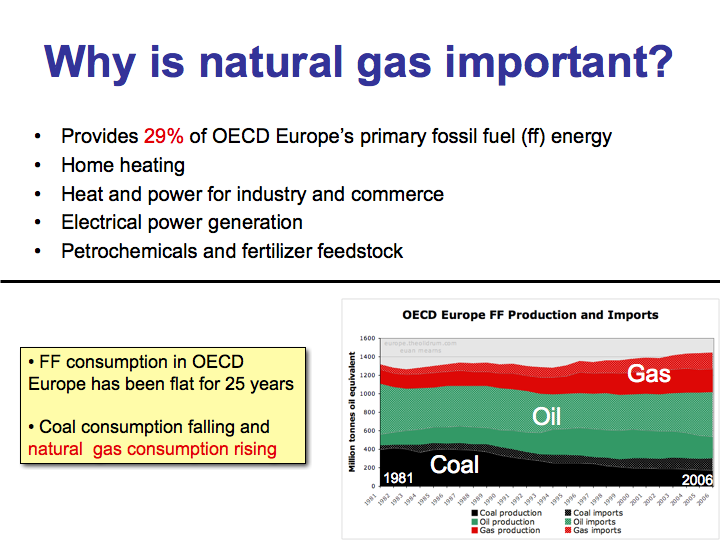
Natural gas provides 29% of OECD Europe’s primary fossil fuel energy.
It is used for:Home heating Heat and power for industry and commerce Electrical power generation Feedstock for chemicals and fertilizer For the last 25 years fossil fuel consumption has been more or less flat in Europe. But as the use of coal has declined, the use of natural gas has increased.
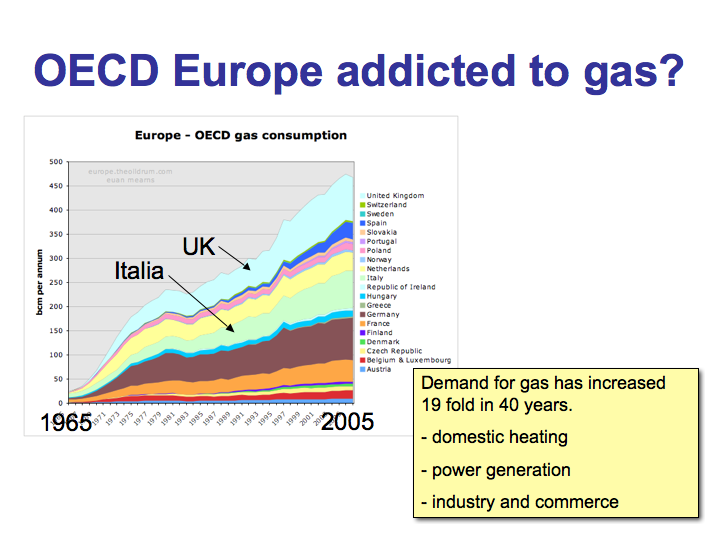
In the last 40 years, Europe’s consumption of natural gas has increased 19 fold. I think this is really quite an astonishing chart showing how our use of and reliance upon natural gas for fuel has grown.
As we shall see later, this was made possible by rapid growth of natural gas production in the North Sea. This bounty whilst not yet exhausted is getting tired and is about to go into decline causing major problems for European gas and energy security.

Since we are in Italy, it is worth spending a moment looking at Italy’s reliance on natural gas. Italy does produce some gas - 11 bcm in 2006 and falling. This is compared with consumption of 77 bcm. So Italy like all other OECD European states, apart from Norway and The Netherlands is dependent upon imported gas.
Natural gas makes up 38% of Italy’s primary energy consumption and 48% of electricity generation.
Italy is more reliant on imported natural gas than most other European states – which is perhaps the reason Ugo asked me to give this talk☺
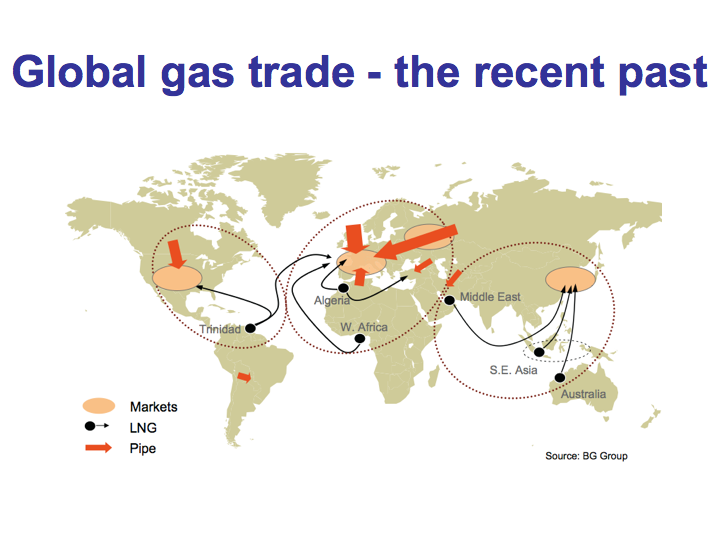
Historically, gas markets have been regional with points of consumption close to supply linked mainly by pipelines – N America, Europe and Russia. The main exception has been Japan / S Korea that has a long established LNG supply train.
This and the following slide are borrowed from this presentation by BG Group (large pdf).

This picture is in the process of changing. Emergence of new markets for natural gas made possible by growth in LNG. S America, India, China and the Middle East – not shown on this map.
LNG provides much greater interconnectivity of markets, greater competition and is rapidly leading to harmonisation of prices.
Not shown on this map is the declining production in traditional sources of supply in N America and Europe.
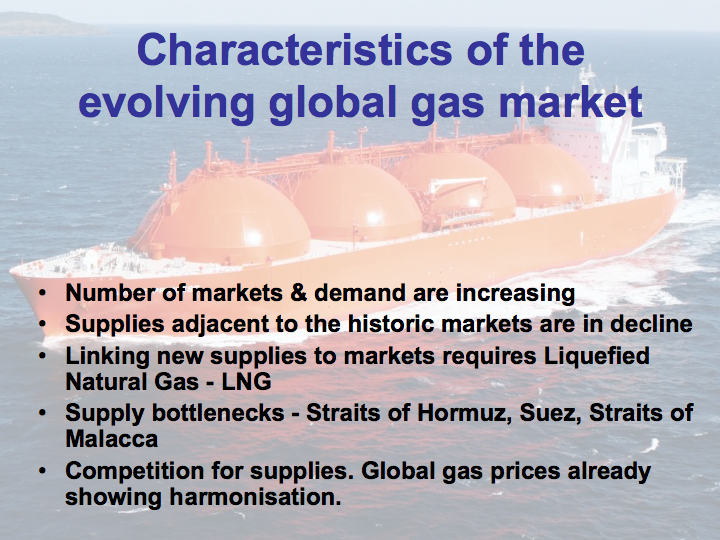
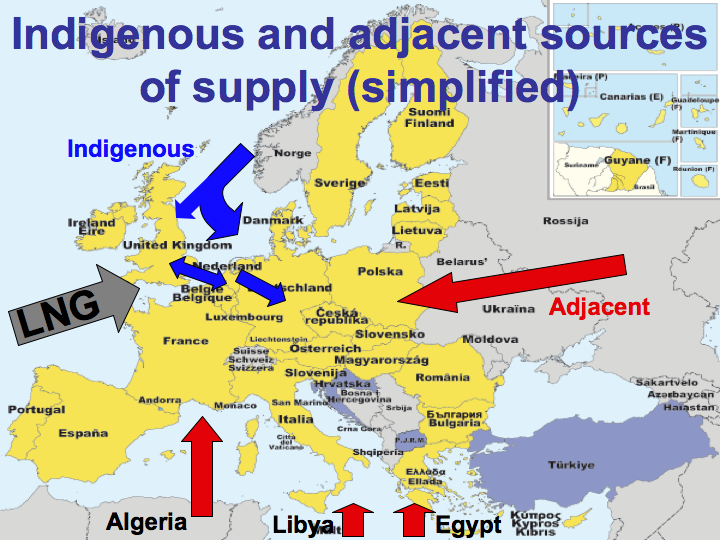
This simplified map shows the principal supplies to Europe. These correlate with security of supply and understanding of that security.
Indigenous supplies are most secure and we know most about them
Adjacent supplies are less secure and are less well understood
LNG supplies are fairly well understood – but we don’t know how the market will allocate supply to Europe and those supplies transported by ship are least secure.
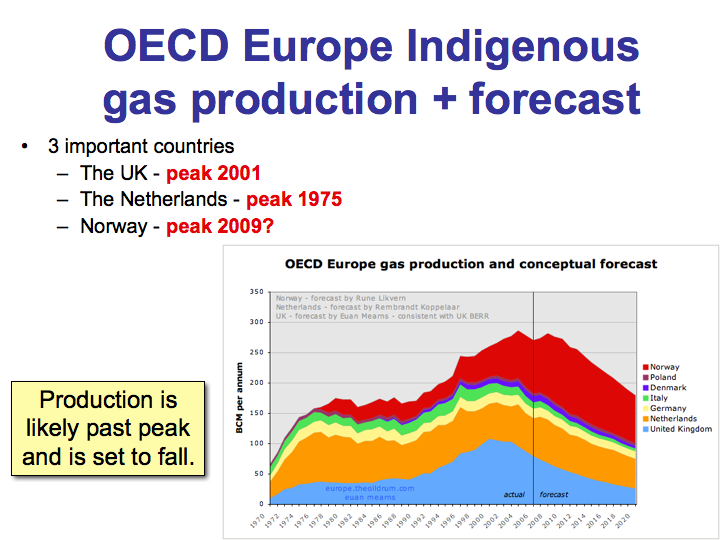
The main features:
Three important countries: The UK, The Netherlands and NorwayThe UK gas production peaked in 2001 and is declining at 8.5% per annum – there is little disagreement on this point – the UK BERR (government) agrees with this scenario. This is one of Europe’s biggest gas supply problems since the UK used to export a little gas and is now looking to import increasing amounts of gas every year. This is placing considerable strain on the whole European gas market.
The Netherlands have had a carefully regulated gas industry with production in Gronigen pegged by law. This has resulted in a very broad production plateau – a very sensible strategy. The offshore Holland gas production is now in decline (like the UK) and this will lead to slowly falling Dutch gas production.
Norway is at a crossroads. The production gas export system has recently been expanded to 120 BCM per annum with the addition of the Langeled pipeline linking the Ormen Lange Field to England (and to continental Europe). The two giant gas fields, Ormen Lange and Troll and can go on producing at a suppressed plateau for many decades. But many of the other North Sea gas fields are in decline. Especially the oil associated gas and the combined prognosis is that Norwegian gas production may peak next year – a forecast provided by Rune Likvern – an informal contributor to The Oil Drum. This has been confirmed by informal releases from the Norwegian Government and the peaking of Norwegian gas will have profound effect upon European gas security.
In summary, the prognosis for indigenous European gas production is quite bleak. Peak was probably in 2004 and in future we can look forward to relentless declines.

If we combine this European production forecast with a consumption and import model projecting historic growth in demand into the future we get a picture of rapidly expanding gas imports.
In 2006 we imported 197 BCM natural gas and this model scenario projects that growing to 492 BCM by 2020 – that’s only 12 years away.
Where will all that new supply come from?
We are already seeing signs of high price rationing demand and I don’t believe this scenario can or will unfold. When I made this chart I sketched in this line indicating demand curtailment – and I will try to quantifying this at a later stage.

As this map shows Russia has many gas fields in West Siberia and the Yamal peninsula indicated here in red. Historic production was dominated by 3 supergiants – Yamburg, Urengoy and Medvezhye. Since 1970, these three fields provided the bulk of Russian gas production – powering the Soviet Union and Western Europe.
These three supergiants are now in decline – this is no secret – the data has been published.
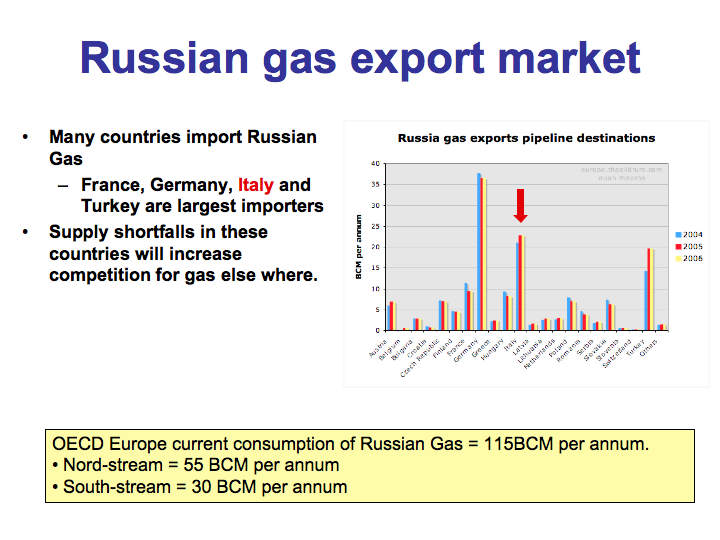
In 2006 Russia exported 115 billion cubic meters gas to Europe. The three most important importing countries are Germany, Italy and Turkey.
New pipelines planned will provide 88 BCM new import infrastructure.
But will this bring new gas, or old gas via a new route? This is one of the most important questions to answer.
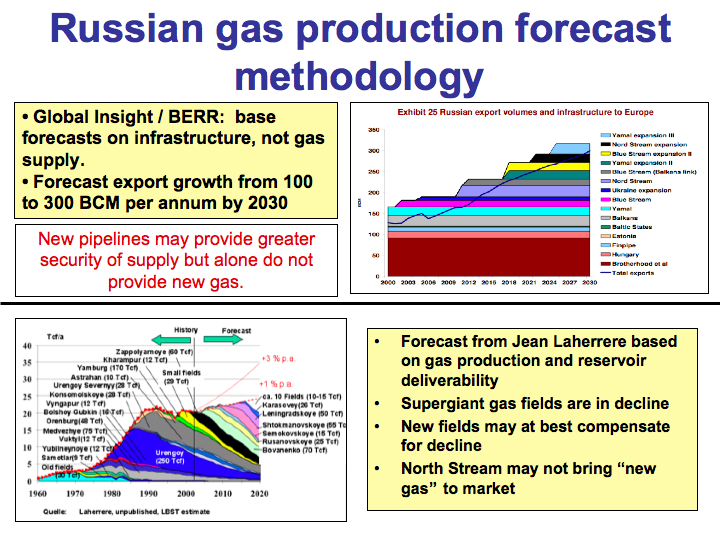
These two charts show two very different pictures of Russian gas production forecasts.
The upper chart is based on existing and new pipelines from a forecast commissioned by the UK government. This shows export capacity doubling from 120 to 300 bcm per annum by 2030.
This is what the UK government wants to believe will happen?
The lower chart is compiled by Jean Laherrere and is based on decline modelling of existing fields with new field developments stacked upon the heritage assests of Yamburg Urengoy and Medvezhy.
This shows fairly flat Russian gas production forward to 2020 – this has a more realistic feel.
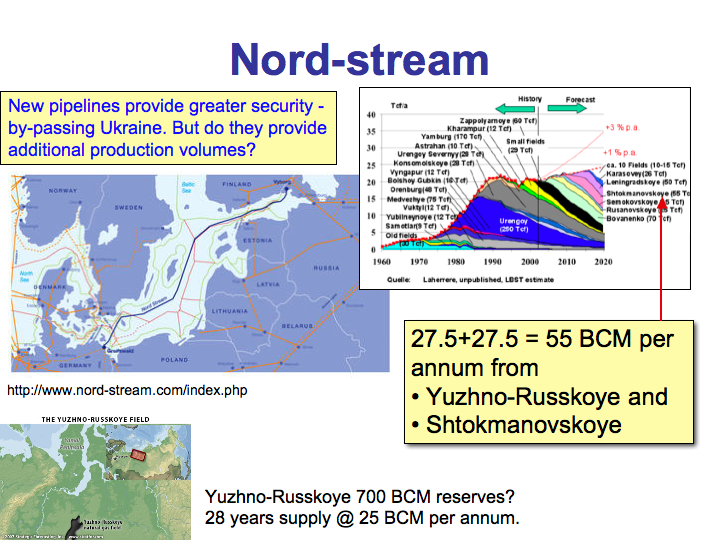
Much hope has been placed in new pipelines being built from Russia. Nord-stream will produce gas from fields identified by Laherrere that will merely compensate for the decline from existing fields.
If this is correct then it will not bring “new gas” to Europe but will merely maintain existing production levels.
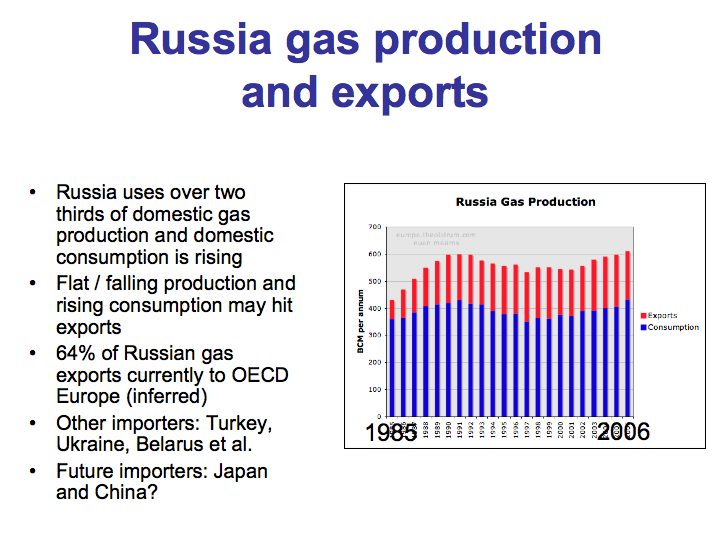
This is a very important slide. It shows that Russia consumes two thirds of its own gas production. It also shows that other countries import gas from Russia – notably Ukraine and Turkey.
Exports are very sensitive to any downturn in production or upturn in domestic consumption.
With the data we have it is near impossible to model these variables.
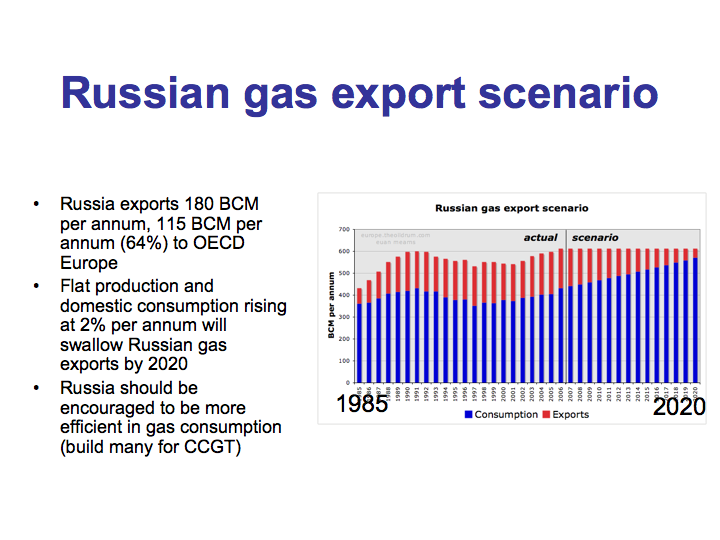
With flat production and a continued rise in Russian gas consumption, exports could fall dramatically between now and 2020.
How would these reduced exports be allocated.
I’d guess to the richest countries who can pay the highest price – perhaps via the new pipelines.
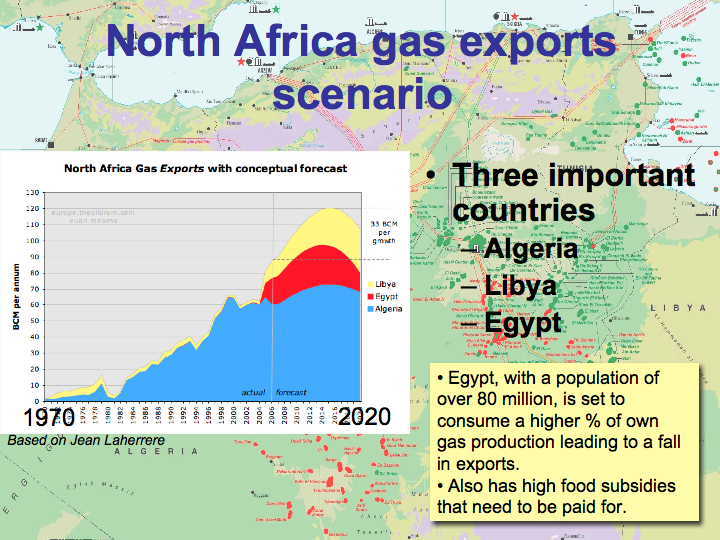
North Africa is already linked to Europe by pipelines, and production and exports from Libya and Egypt are expanding.
Most of N African gas production comes to Europe and this source of supply should continue to grow until about 2016.
But note that Egypt is forecast to consume more and more of its own gas production that will lead to a peak and then decline in exports.
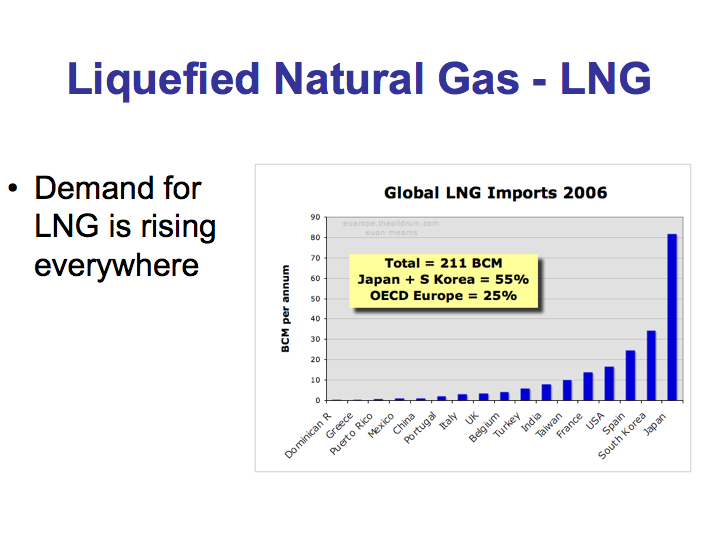
We now move on to look at how the LNG market might evolve.
The market is currently dominated by Japan and S Korea.
Total production in 2006 was 211 BCM and Europe had 25% share of that market.
How will future LNG supplies be allocated? That’s a difficult question to answer.
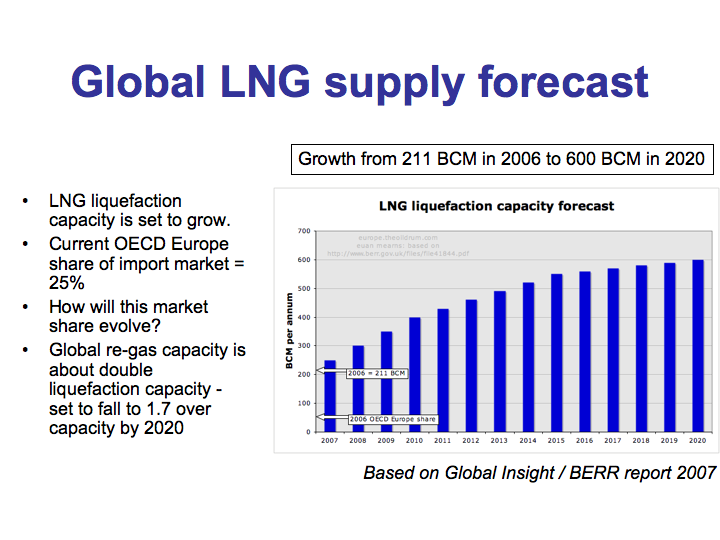
This is a forecast of how LNG supply is forecast to grow, prepared on behalf of the UK government.
It should grow from 211 BCM in 2006 to 600 BCM in 2020.
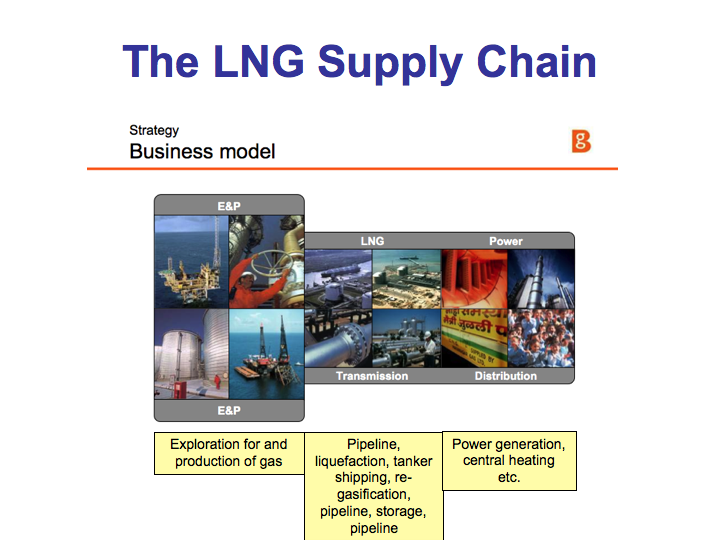
The LNG supply chain is long and complex. Note that we must contemplate storing LNG during summer by re-injecting into depleted gas reservoirs.
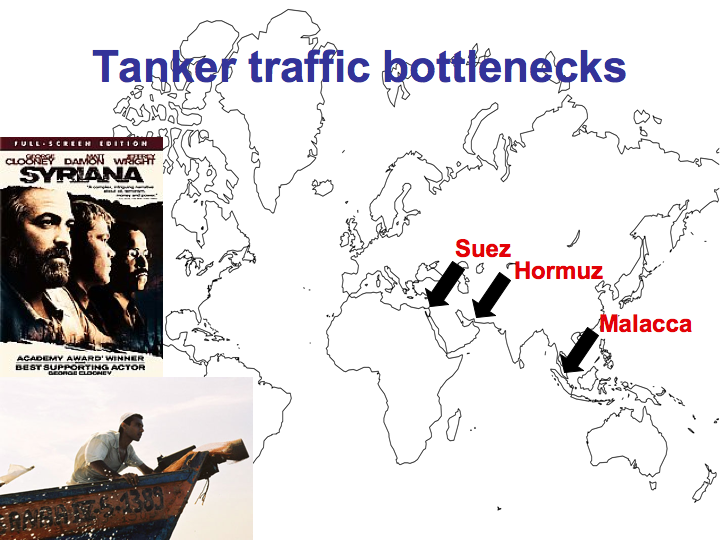
LNG tankers are also vulnerable in three notorious tanker bottlenecks in Hormuz, Suez and Malacca. The malicious actions of a very few individuals there could seriously disrupt gas supplies to Europe – disrupting industry, commerce and electrical power generation.
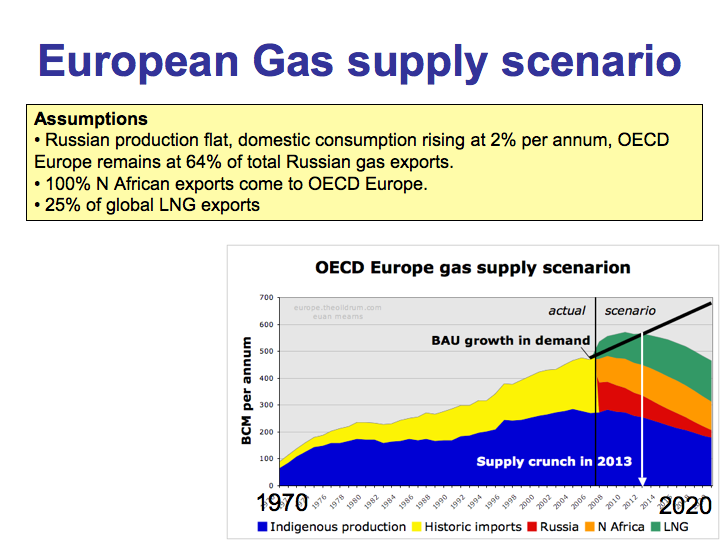
So how does all this information and speculation add up?
By making the assumptions indicated, a supply shortfall is indicated by 2013. If this were to happen, then Europe would have to learn to live with less.
This is subject to many uncertainties that could work either way – the shortfall could occur sooner or later.
The main uncertainties are:
Norwegian gas production Russian gas production and export forecasts. The share OECD Europe gets of these exports. The allocation of LNG exports.
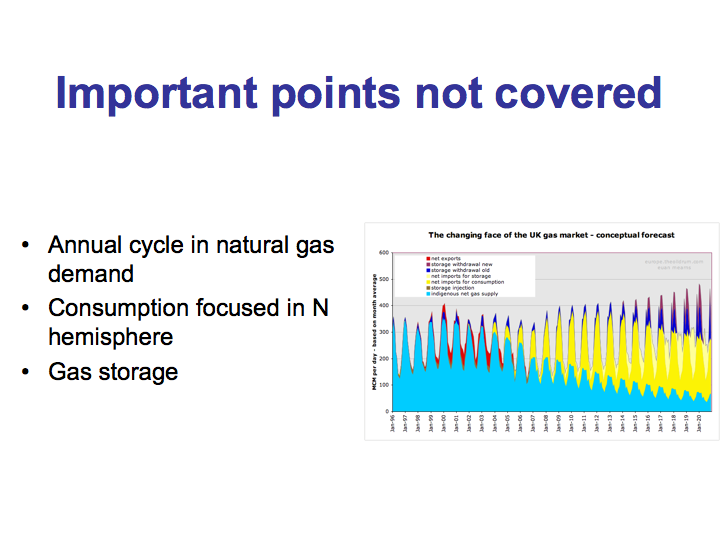
In developing gas supply scenarios it is also very important to be aware of the cyclic seasonal nature of gas demand.
The fact that most demand is centred on the N Hemisphere creates an annual global demand spike
There is a need for increased gas storage throughout Europe in order to smooth out that seasonality. This may also smooth out seasonal pricing with consequences for the gas storage industries.

Further reading on The Oil Drum
The European Gas Market by Euan Mearns.
Daddy, will the lights be on at Christmas? by Euan Mearns.
The ASPO-Italy conference in Torino by Ugo Bardi.




Nice presentation!
If I were in Italy, I would be concerned about the 48% of electricity production that comes from natural gas. Are there any real options that can easily be increased?
It isn't just Italy that can expect gas (and hence electricity) supply problems soon.
There are 27 states in the European Union, the UK (to name but one other state) also produces around 40% of it's electricity from gas - caused by the UK Government's attempt to meet the Kyoto emmissions targets.
http://www.iop.org/activity/policy/Publications/file_21079.pdf
Gail - the UK is currently preparing to expand the fleet of CCGT's (combined cycle gas turbines) by 12. All we hear in the news is consumers and government wailing about ever higher gas prices. They don't seem to understand that increasing demand against near static supply will inevitably lead to higher prices.
Europe will start to import more coal and I fully expect the UK to re-start mining deep coal - Dave Rutledge watch out!
And in the UK we have had a U turn on nuclear policy - but rather late. Italy has a non- nuclear policy but I believe they import nuclear electricity from France. France will become the nuclear King of Europe, exporting electricity and reactors.
Russia and central Asia are wild cards in all this. It is possible that the Russian scenario is worse than depicted here if their production actually starts to fall. But this could be compensated for by increased production in central Asia - Turkmenistan and Kazakhstan.
What Europe really needs is a crash program for expanding all kinds of sensible renewable energy combined with a crash program of energy efficiency measures
Greetings to all,
As a speaker at the congress of Aspo Italy 2, I submitted a plan based on renewables and energy efficiency to reduce dependence on gas and oil. Considering all contributions obtainable those strategies we could stabilize gas consumption, reduce strongly the use of oil and hit the Kyoto target by the 2012. If every country in Europe could do this the gas crunch would be delayed in time, giving us more time to develope new solutions based on troposferical eolic or photovoltaic or even on new generation nuclear power. The fast approach of gas crunch is mostly a matter of increasing natgas consumption all over the continent. A strategic agreement with Russia is strongly needed, not only to realize new gas infrastructures, but even to increase energy efficency in gas use. Repowering of old soviet gas fired power stations with combined cycle and better insulation in central district heating stations could stop the increase of internal gas consumption making available stable gas amounts (and incomes) for export, while big european consumers, Germany, Italy, France and so on try to reduce consumption by efficency and renewables. Europe needs more time to develope solutions; Euan showed us that time could be too short to buld new nuclear plants before gas crunch happens. Efficency and renewables are quicker ways that can perform better.
Eugenio
Hi Eugenio,
Thanks for your post. I'm curious- what happened (WRT your plan) after your presentation?
Did you attempt to have your plan adopted? If so, what steps did you take and how was this received?
Or, did anyone contact you about it?
Was there a gap at implementation? And, if so, how do you suppose this might be overcome?
Thank You Aniya
ASPO Italy 2 conference was divided in two sections: problems (Euan's presentation was in that section) and solutions. My plan was designed to show that ASPO Italy focuses on solutions and to demonstrate quantitatively that renewables and efficency can be a feasible short term solution even if we consider only mature technologies and existing subsides.
No special expression of interest was done by local politicians, it is a post electoral phase in Italy and everyone is waiting for the magician nuclear, LNG and clean coal solutions promised by the new government.
By the way there is some interest inside ASPO so I am working to do an english translation of the plan.
Regards
Eugenio
Eugenio - you can always send a copy to Ugo for consideration at TOD as well.
Yes, sure, I will do it.
Bye
Eugenio
Gail,
There are several alternatives to electricity generation by gas;
Geothermal is baseload generation, Solar and Wind are intermittent and need hydro/CAES/etc storage as well as an effective demand management approach for high levels of penetration.
Geothermal Power

Solar Power

Wind Power (Purple and Red are best sites)

Hello Euan [also to Jean L],
Thxs for this ASPO info from Italy. BTW: anybody do the yeasty half-glass Peakoil Shoutout?
I would assume that any natgas for Haber-Bosch N is already removed prior to liquifaction of the remainder? And the LNG data is correct for this? In other words: less energy losses by early natgas conversion to non-high-pressurized, non-super-cooled liquid or powdered fertilizer, then easily shipping it long distances in this new form.
Or is my assumption wrong and much LNG is later H-B fertilizer converted in Europe, Japan, and other countries. Thxs for any reply.
Bob Shaw in Phx,Az Are Humans Smarter than Yeast?
Bob - I have to assume that LNG is very pure methane (CH4) and that all longer chains are removed at source to fuel the growing petrochemicals industries in the gas exporting countries.
One problem here is that these longer chain gasses that are frozen out during processing are classified as NGL (natural gas liquids) which many (including myself) are counting in the global all liquids production tally. They're not really liquids but gas.
I don't know to what extent European fertilizer production has been run down and "off shored" - I'd like to know so if anyone has information in European ammonia fertilizer imports please post it here.
I don't recall the yeasty half glass but do recall many ruby red glasses of very fine Italian wine.
I only have a little bit of outdated information, based on someone I knew involved with Russian fertilizer exports from Kaliningrad in the mid-1990s. A very much cash based business, if you understand what is meant behind the polite term 'cash.'
And that information is, that if you are looking for hard numbers from a major world fertilizer producer and exporter, forget it. The business was (and likely still is) remarkably opaque, in part because the customers are countries which find trading with Russia about their only alternative (Bulgaria, for example), or are simply desperate for fertilizer, like China, and in both cases, their numbers are equally opaque.
Another reason, perhaps surprisingly, is that much of the fertilizer he was involved in exporting was essentially not used in Germany (at least according to him) - he talked about how German customs was utterly uninterested in the sacks of it he used to carry back to Germany in his car - including ammonium nitrate. It wasn't illegal, it was simply not used, and thus had no value in the eyes of the customs agents.
At least in Germany, fertilizer use is not encouraged. Noted, for example in this passage -
'In Germany, legislation rules many environmental aspects of agricultural plant production, and special laws are in force concerning fertilizer use, soil protection, and pesticide use. In sugar beet, nitrogen fertilizer use has decreased greatly and may be reduced further in some regions. A further reduction of potassium and phosphorus fertilizer use does not seem to be appropriate.'
http://cat.inist.fr/?aModele=afficheN&cpsidt=15044219
Admittedly, Germany is not typical, but I'm not sure that that fertilizer production has been offshored as much as it has been downsized.
Which would fit into the typical German style of handling future resource restraints - seeking substitutes while reducing use. Much like home insulation standards to reduce the need for gas for heating.
These are not crash programs, by any means, but they at least tend in the right direction.
Of course, France is often at the other end of this spectrum, so it may all balance out in the larger view.
expat, this is interesting.
Though
re: "fertilizer production has been offshored..."
seems not exactly to match with....
"...tend in the right direction."
Great presentation. We will have to see how the new Qatar production affects these graphs. Quite intriguing to see Italy so dependant on natgas. If LNG is to be the new hit, we have yet to see all the production come on line. We seem to be lacking the capacity to build capacity. Yet agaain, im just a newbie
LNG supplies from Qatar are included in the above. We have no problem building LNG import facilities - the problem is expanding export facilities which are dependent upon actual gas production.
The other big uncertainty is the share of global LNG that will come Europe's way. The main competition here will be between Europe, USA, China, India and the established markets in Japan and S Korea.
Euan,
This is very good stuff. I am very concerned about the effects of Peak Gas on the UK.
Two questions:
1. How much energy goes into liquefying the LNG and how much of this is wasted? I ask because it presumably increases the overall CO2 emissions associated with natural gas use (although no doubt for 'official' accounting purposes, the LNG liquefaction counts in the CO2 emissions for Qatar, etc., rather than in the UK).
2. We can no doubt look forward to higher gas prices and more volatile ones. What concerns me is that the volatility will make it very difficult to plan finance for future gas-fired electricity generation. I'm no so worried about straight CCGT baseload generation as more esoteric gas CHP with heat storage that could be used as a flexible complement to variable wind, tide and wave electricity. So will future gas prices be so volatile that no-one will touch gas as a fuel with a bargepole?
Myself, I can't help feeling that the UK should be emulating the German programme of insulating the buildings stock as quickly as possible (and adopting Danish style CHP) before the gas price gets horrific (and the whole population is cast into Fuel Poverty).
Note: By my calcs, it will require about a cubic kilometre of insulation to make a good job on the UK building stock, so we'd better ramp up insulation production asap.
BobE
I agree entirely with this view. But what chance do we have with the current crop of totally ignorant and spineless "leaders" we have?
add the following to totaly ignorant and spineless:
We are fast running out of money.
No room for tax reductions: - All tax is required just to feed the payroll vote and social services
Food and fuel inflation.
Corporation taxes about to fall due to the crippled city of London and other, failing service businesses
Unemployment about to go up.
Try a radical strategy under these circumstances - just not possible.
We are out of time Euan. There is no wriggle room left. The Nuke option may not now happen at all under a crippled Prime -Minister.
The economic growth which has come from the financial services pushing personal debt to record levels
According to
http://www.creditaction.org.uk/feb.html
we are paying £259 million a day on interest on loans. £3,800 per household per year.
Prudent?
Lets see what happens when the boomers retire.
http://www.moneybasics.co.uk/resources/news/2004/september-2004.html
Thats if our younger generation haven't all killed each other before then :( sad times
If the catholic church wanted to do something useful perhaps they should be ranting about usuary not abortion and embryo research.
/rant off
Hello,
Normally 85 – 90 % of the nat gas fed into the LNG process becomes LNG.
NGM2
Euan, have you heard anything regarding the reliability of the North Field reserve estimate. I remember Qatar put a hold on new LNG prospects for a bit and there was discussion that it might be because the field is smaller than estimated. But I have not seen anything more about it. Thoughts?
Informative presentation.
OT: Who makes the physical barrels that oil is contained in? Where can a small business purchase these empty barrels?
Euan
Your "crunch" of 5 years hences also unfortunately seems to align with a "crunch" that will occur in the US (if recent posts on drilling for NatGas in the US are accurate, their EROEI is trending toward 1)
The impending shortage seems to have been anticipated by the Swiss, hence their recent agreement with Iran.
Interesting times
Neven
I'm surprised that people aren't mentioning natural gas use for cooking. Sure, heating and electricity generation is a really big deal, but surely so is the availability of cooked food?
Electric or wood or solar ovens/hobs can make up some of the shortfall, but if you think about most homes and commercial kitchens, natural gas is critical to preparing and cooking food. Conversion to electricity is going to increase demand on the grid immensely and, relative to burning gas at point of heat requirement, disproportionally. This gas crunch will obsolete the cornerstones of millions of kitchens - think of all those big stainless steel range-style hobs with 5-10 burners that are presently all the rage.
So my questions are: if natural gas looks like becoming crazy-expensive in around 5 years, how will you and your family cook your meals? How will restaurants and large-scale pre-cooked food producers (Ginsters, supermarkets, ready-meals etc)? Will the available supplies of wood and electricity even begin to cover the needs of the cooking masses? Any suggestions beyond electric, wood and solar?
Thanks,
Jim
In the UK at least, domestic consumers pay the highest price and are also guaranteed to be cut off last. So industrial and commercial users and power generators will get cut off first and it will hopefully be a very long while until domestic gas supplies get cut.
Electricity brown outs are more likely in the near term - so it better to cook with gas.
This year i will replace my old gas boiler with a new more efficient condensing boiler and fit a wood burning stove in the space vacated by the old boiler - thereby building in long term resilience to the Mearns household:-)
Thanks for this piece Euan.
When you add political factors such as for instance how Britain is currently at odds with Russia diplomatically, we might find ourselves further down the supply chain than we might like.
Also I do wonder if, when it becomes more widely appreciated that this energy crunch is not a temporary one that priorities for gas supplies within the UK might change. If domestic customers are given priority then industry may collapse faster than it otherwise would, consequently our ability as a nation to purchase further, increasingly more expensive fuel supplies may reduce more rapidly.
Euan,
Good article.
Glad to hear that you are swapping toa condensing boiler and a woodstove, in order to reduce your exposure to volatile natural gas prices.
This is the route I followed starting with a new condensing boiler in 2005, and a woodstove/boiler installed in the old fireplace, when vacated by the old inefficient gas back boiler.
Four tips ( to save you loads of money and improve system efficiency)
1. Select a condensing boiler to suit your property. Don't be fooled into buying a 24kW model, when your house only needs 6kW to keep it cosy.
2. Turn down the output water temperature control on your condensing boiler to about mid-way. Water returned at too hot a temperature will not allow the boiler to run in its efficient condensing mode.
3. Link the woodstove to the gas boiler with a System Link ( google them - based in Dublin). A fraction of the cost of the equivalent Dunsley Baker neutraliser.
4. Fluestore dot com is the cheapest source in the UK for the approved woodstove flue liners.
2020
Thanks for the tips 2020. I wasn't thinking of linking wood burner to hot water system owing to complexity and cost. The quote I have from Scottish Gas (Centrica) is £5K for the boiler and installation though I'm told a local plumbing firm will likely do the job for a fraction of the cost.
So do you reckon its quite important to link the wood burner to water system? Our house is pretty well insulated so I was reckoning that when wood burner is on that it will heat through most of the house and the gas central heating would be off.
And being Scots we stopped bathing 200 years ago.
How about adding in a solar water heater. I have a 20 tube vacuum system (DIY installation for £600 using a retrofit coil). I estimate a 20 tube system will deliver approximately 1500-1600kwh of hot water per annum. From now until mid Sept the solar panel will provide 90% of my hot water with the boiler doing just a little work on dull days / high demand days.
Despite popular opinion, places like Edinburgh in Scotland are well suited to solar thermal as a component in a solar assisted space heating system. Here's the abstract from a paper presented at EuroSun 2006 in Glasgow
Although Dublin comes out tops, the author (Kerr Macgregor) states that
Personally, I like the Azur solar collectors available via Construction Resources.
http://www.constructionresources.com/default.asp
They're flat plate with turbulent flow and claim up to 85% efficiency. I prefer flat plate to vacuum tubes simply because I think they'll be more robust. The Azur collectors came out top in a recent Which? survey.
I'm considering an installation using solar thermal panels coupled to a heat store (see Construction Resources). Solar heat would be complemented with a natural gas fired boiler initially and later a wood fired boiler.
Renewable Ali.
I couldn't agree more that residential solar thermal is the way to go, and should in my view be compulsory on new builds.
Have you a link to this important paper?
In my view in northern latitudes PV for any grid connected property makes little sense, certainly to the utility which still has to provide power when it is most needed in the winter as you get very little out from the PV set up in Dec, Jan and Feb, but must take power from the set up in summer when it is not needed.
It is a very different matter in more southerly areas where seasonal variability is not so great and anyway peak load is in the summer in hot weather.
No one solution works everywhere.
Residential solar thermal though is certainly an effective resource at northerly locations, although I do not follow the logic of it's being superior to southerly locations, so would be very interested to read the paper and get a fuller explanation.
Its not just the boiler, its how it gets used. My horrible 73% efficient back boiler has a flue that passes up through the house. When the exhaust gases pass out of the chimney at the top they are cold, so much of the 27% of the so called lost heat probably ends up in the house anyway.
many combi boilers cycle when the hot tap is turned on as well. Hot water is not needed for handwashing. My boiler is only on in the day in very cold weather, the residual luke warm water in the tank from the night before (after the wife and kids have drained the tank)does for hand washing, so no boiler and no gas required. Cavity wall insulation suprised me on how effective it was after I had it done.
I'm not anti condensing boilers, but they have gone the way of new cars in that you hand your self over to the technology that controls them. My back boiler has a piezo crystal ignitor and a gas valve and has so far lasted 22 years without a single fault, the cast iron heat exchanger is as good as new.
We all live in a luxury that is simply not required. The solution is big jumpers and learning to knit again.
It a bit Jevons' Paradox(ish) that if you install something that is more efficient, you become more relaxed about how you use it. When I got my first diesel car, going from 33 to 50 plus mpg, a guy told me I would just do more miles, its true. The only answer is rationing, how you waste your ration is up to you.
Euan,
If you are changing your system it is probably a good idea to step back and look at other possibilities.
A wood stove with back boiler makes a perfect complement to solar water heating. Even in a Scottish summer you will get sufficient hot water to allow you to keep your gas boiler off fr weeks on end.
Between Autumn and spring, you can supplement the output of the solar water heating using the woodstove boiler, as well as using the woodstove to convey useful heat around the house via the central heating circuit.
IMHO, this will give you the best strategy to effectively decouple yourself from massive increases in natural gas prices.
Might I recommend the Navitron forum for technical discussion of the above.
Partypooper - I also had a 25 year old gas backboiler, which I tolerated for the first 5 years of moving to this property. During the summer months, when the boiler was seldom used, I measured that the piot light was consuming 6kWh of gas per day - none of which was contributing any useful heat to the domestic water. Eliminating the pilot light effectively saves you almost 2200kWh of wasted gas per year.
Between 2001 and 2007 I effectively eroded my gas consumption from 28200 kWh pa to 13400 kWh pa. The condensing boiler was fitted in 2005 and reduced the annual bill from 20,000kWh to 14,000kWh. Solar water heating followed in 2006 taking a further 600kWh off the bill.
If you have access to a source of firewood, now is the time to consider making a move back to solid fuel.
2020
2020
I used to joke about the cost of running the pilot light, though I have never measured its consumption, and always turn it off when i'm on holiday for that reason, but it probably does slowly warm the water when we are in the house. For hand washing in the day you only require tepid water. I know Baxi were able to increase the seasonal efficiency from 73% to 78% by going to spark ignition. I use gas to cook and my bill is £26 a month. I don't know how this compares with the uk average. My average electricity use is about 480 watts continiuous consumption, which is about average for the uk. I took the decision years ago not to buy a larger property because I have long anticipated the cost of energy increasing. I also took advantage of the grants being offered for cavity wall insulation.
Its a difficult one because my main energy cost is transport, and this dwarfs my gas bill even though I drive a small diesel. Unfortunately my job involves travel, for how long it can go on does concern me to some extent.
2020 (again)
I made the point about simplicity, you make the point about returning to solid fuel; they are one of the same. We are so tied up in the technology web, the failure of the electronics within domestic appliances can easily render the appliance useless and that applies to condensing boilers, and to stray a little, also modern car engines.
If society breaks down a level or two, one could not use the reminants and say turn a modern car diesel into anything useful, for intance a generator. The complex injection system requires to be coded with the imobiliser, period. 15 years ago the injection was purly mechanical and the engine could be operated with nothing more than a 12V electrical supply. I went to a scrap yard the other day for a door lock. There are cars in there that have no corrosion, they are scrapped due to electrical and engine management faults that cost more to put right that the vehicle is worth.
The most recent generation of cars uses addressed door locks etc on a "CAN" network so no one other than those with the communications kit can do anything, including using a second hand part from a breaker. This is not the way forward in terms of sustainability. It will result in just more servicable cars being scrapped because of repair costs. The energy to manufacture a car is high, I would love to know the real life cycle energy savings all this electronics really provides, probably none at all.
Partypooper,
My wife and I both drive Peugeot diesels manufactured in 1994. I have had mine for over 10 years and amazingly it scrapes a new MOT test each December.
I fully appreciate your comments about automotive electronics being a major nuisance when they go wrong. All a 1980 designed diesel needs is a fully charged battery to start it.
Mine is a 405 estate that gets about 40 to the gallon, her's a 106 that can get about 60 to the gallon. It is not surprising that I often borrow her car when making a long trip or one with a lot of sop start driving. My mileage is approaching 200K, the much smaller 106 is about to turn 100K.
My neighbours wonder why we drive such old cars - well we don't see a car as a status symbol or fashion accessory which requires updating every 2 years.
My diesel tinkering extends to the shed behind my house where I have a 3kW Lister diesel generator set, which is being adapted to run on woodgas.
2020
2020,
Your on my wavelength. My wife's car is a Rover 218 turbo diesel 1995 M reg which has the lucas mechanical distributor pump and Peugeot XUD17 engine and does mid to late 40's mpg. 160000 plus miles later and just a water pump. I had Montego Diesel with a Bosch Mechanical pump. It was direct injection and would start without heater plugs, though not easily in very cold weather, but it would still fire after few seconds of cranking and returned over 50 mpg (you probably know the XUD is IDI and little less efficent)
I now have V reg (and identical spare 53 reg) Rover 25 Diesel, no more economical than the Montego, with a CAN bus linking the main ECU (Bosch EDC15M) to another ECU in the fully electronicly controlled Bosch VP30 fuel pump. God bless the engine malfuction Indicator lamp! It is completely imposible to operate the engine without the ECU in the vehicle, which itself needs a unique coded signal from the imobiliser (you cannot swap the ECU from one vehicle to another to test it without recoding it to the imobiliser).
I used to work on water treatment sites and often hired generator sets with the small Petter (6 BHP @ 3000rpm) fitted. The economy was amazing compared to the Honda petrol eqivalents both having 4kW alternators attached. Only a starting handle required, though on cold winter days starting them was very good physical execise!
A very good question. The other day I heard a piece on the radio about making "bread" (that is, massively over-processed, ready-sliced, industrial pap). The man from the bread company proudly explained how they created a crispy crust on the "product" by blasting loaves with super-chilled, moistened air as they emerged from the oven.
It is one small example of the energy intensity of the modern food chain (although I couldn't guess whether or not, given the scale of the operation, the factory bread uses fewer production calories per food calorie delivered than traditional bread made with stoneground flour).
There is obviously scope to reduce the energy intensity of food to allow for future reductions in available energy. It might prove more efficient in future to produce and distribute certain kinds of cooked foodstuffs on a large scale than for people to use meagre and costly supplies of energy to produce them at home. Did someone say soup kitchens?
La plus ca change...
In the old days people used to take their bread to the baker, to be cooked in the big ovens there.
Many, when they ate at all, would eat in a chop house, as they had no cooking facilities at home.
I suspect that in a modern kitchen most will just microwave more, although other alternatives could come forward, as an open cooker is a pretty inefficient alternative - a heavily insulated pressure cooker with a built-in electric element or a slow cooker built in the same way should be several times as efficient as present arrangements.
The heat form a fridge is also currently wasted, and cold presumably be utilised either for hot water or, perhaps, cooking.
Heat from a fridge is only wasted for about 20% of the year in the UK, eg sometime during approx May - Sep. The rest of the year it is adding to household heating and is therefore 100% efficient, just like incandescent bulbs and all other appliances are 80% of the time. I would though like to see a closeable duct through the house wall for fridge exhaust allowing it to vent heat in summer.
An interesting article from the NY Times on Gazprom:
Hello €,
and thx for sharing
Note in your snippet the important part (in bold by me);
“Over the next two years, Gazprom plans to triple its capital outlays in its core business of exploring, extracting and transporting gas — just to maintain its current production levels. Investments will rise to 969 billion rubles, or $45 billion, in 2010 from 330 billion rubles, or $14 billion, last year.”
Looks like Gazprom, like the Red Queen, in the future has to run faster to stand still.
NGM2
I seem to remember reading that the end-to-end LNG process took about 15% of the total energy contained within the transported fuel.
Since goods produced with Petrochemicals have a higher margin (and hence lower % transport costs for end product) would it not make increasing economic sense to produce items with a high % content of FF at source?
I think we are seeing the start of a major triple whammy here in the UK: Oil(transport), Gas(Electricity, heating), Food('FF inputs'): Likely outcome: higher Inflation, collapsing real house prices=wealth evaporation.
All of a sudden 'Cool Brittania' becomes chilly ill-wind blowing Brittania...
Nick.
Shock and awe
Shock Increase In The Cost Of Living
UK house sales slump to record low
Talking of housing.
Government's secret fears over housing market exposed by minister gaffe
"Accidentally". Well it's one way to hasten the end of the buyer-seller stand off in the housing market. The crash can't be over and done with until it starts...
Suggestions please for how Gordon will accidentally confirm the Gov't position on peak gas. I'm going for a Post-it note on the dashboard of his official car.
The BBC had a 1-hour phone-in on oil prices and future supplies today. http://www.bbc.co.uk/radio/aod/radio4_aod.shtml?radio4/youandyours. Link valid until midday BST on Wednesday.
Shouldn't that be 'socked and poor'? :-)
...as long as the ill wind blows across the vanes of a few turbines to generate a few watts before it reaches my neck of the woods.
There again, wealth is fundamentally a measure of energy. Even if it is stored as gold or money, wealth is only worth the amount of labour or manufactured products it will buy (obviously I'm not talking about spiritual wealth, here). Less net energy = lower net worth all round.
Happily, for most people in the UK, the amount of energy currently wasted nationally on things that are, in comparison to food, warmth and shelter, frivolities is so large that there is great scope for maintaining a reasonable degree of comfort over the next few years through conservation - e.g. Euan's new boiler and wood stove to minimise the rise in his water and space heating costs.
Of course, if or when ff depletion rates exceed the replacement/conservation rates and/or we lose the economic ability to outbid other nations or regions for supplies, all bets will be off.
The UK's ability to out bid other nations while we have a falling currency is one thing that concerns me.
Then print more ££££££££££££££££££££. ;-)
long time reader.
In the United States there is a rebirth in natural gas supply whereby production is increasing via unconventional gas (mainly shale gas in the barnett, fayetteville, etc). I would guess that russia has large reserves of shale gas as well. How will the production from unconventional gas (more than 35% of U.S. production now) affect the forecasts??
Not sure - there are hopes that a lot might be extracted in Hungary through Exxon/Mol/Falcon Oil & Gas - but it all depends on whether they can get it to flow. I should imagine everyone is looking as hard as they can now.
I think the problem in Russia is that the super giant fields Urengoy and Yamburg in decline represent such massive loss of production that you require huge new fields to compensate for it. And this is unlikely to be achieved from non-conventional gas sources.
Furthermore, in the US you are going to extreme lengths to get gas because your well being depends on it now. Russia is still exporting gas and by definition still has a "glut".
What could happen is that in decades to come Russian gas production declines to a level where exports have ceased and the Russian people are freezing to death in winter. Then you could see efforts to produce non-conventional gas sources.
Hi Euan,
I was in Turin but let me ask you some addictional questions now:
- what do you think about central asia former soviet republics gas production, could they contrast the decline of major russian fields and for how long?
- you did not cover a new gas scenario for Europe, far but not impossible to realize: as far the Nabucco pipeline and the Balkan-Otranto pipeline can be feeded with russian gas from south stream, they could be also esily connected to Turkish pipelines. Iran yet sells some natural gas to Turkey and could increase exports to Europe via Turkey. What do you think about giant iranian South Phars gas field? Could gulf natural gas imported by pipeline via Turkey be a feasible solution to avoid the gas crunch (not only iranian but also Qatar)?
- I knew about prospections in the Indian Ocean for a pipeline from Iran to India and Pakistan so a variation to the previous scenario could be a race to connect to middle east gas fields for first. Not everyone trust in LNG market...
Regards
Eugenio
"Unconventional" gas really means "expensive gas". Tight shale or sand produces more slowly, even after frac jobs have been run. The cost is higher.
There is a a over arcing sense of a geopolitics in the reality of gas.
There is a common interest of all the peoples of the Eurasian land mass to keep NG in pipes and pump it around as opposed to letting being siphoned off into tankers.
just from the energy optimization POV tankers equate to a 15% or so loss of energy content via pressurization. It seems to me that the most economically optimum use is to ship the NG from the ME and FSU to markets connected by land. LNG tankers represent a rip off by the western hemisphere.
a mass organised theft that will create opposing views over foreign policy issues... Iran being an obvious one.
The US has an interest in trapping gas in a complex LNG chain as opposed to the pipeline simplification (syrianna). what follows is a complex conflation of interests and policies
this gas issue for europe is a real wedge in former western unity between the US and Europe. divergent interests indeed.
Boris
London
At what level of supply do the pipelines stop working?
For us in the UK that is a pretty imminent concern, as our own gas is running out and we buy our supplies on the spot market.
Norway has openly said that under those circumstances long -term contracts will have priority, so I can easily see gliches where there is inadequate supply to keep the pipes full enough to provide flow, if I have understood the engineering correctly.
What would be the consequences of this, and to what level would they need to drop to cause this problem?
In terms of Russian natural gas production, it should be noted that Gazprom has produced its own projections of future natural gas production, through 2030, on its website: http://eng.gazpromquestions.ru/index.php?id=7
Overall Gazprom is forecasting increased production through 2030 and comfortable maintaince of natural gas export capacity -- there's a lot of info on Gazprom's website and they address the decline concerns and the Yamal Peninsula -- follow the link above.
So it sounds as though in the UK we will simply become more and more dependent on Russian gas - the plans to build off-shore wind are ludicrously expensive to the point of being unfinaceable on any scale, and the nuclear build will take ages the way they are faffing around.
Thx for the link,
Between 2012 and 2025 Gazprom projects to increase their nat gas production by 30 Bcm/a, some of it will ceartinly end up in domestic consumption, substitute declining OECD supplies and some of it may end up in South East Asia.
Gas for cooking does seem to be a significant part of overall consumption. Davemart found a BBC article which pointed out how a popular football game can cause a large peak in power demand from heating tea!
A lot of cooking heat is wasted. Anybody have any data on the relative efficiency of inductive stoves & pans, as well as microwaving?
Here's some info, Nick:
http://www.p2pays.org/ref/32/31144.pdf
31144.pdf
http://www.naturalgas.org/overview/uses_commercial.asp
http://michaelbluejay.com/electricity/cooking.html
Thanks.
Doesn't look like that much energy, after all.
I'm struck by the increased efficiency of just covering pots...